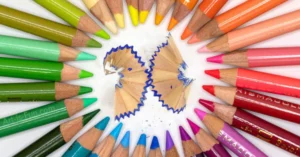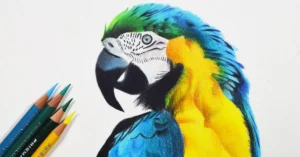Prismacolor Premier Overview
For those artists who like their world a bit more vivid, Prismacolor Premier coloured pencils are for you bud! They come with a reputation for bringing sketches to life with their vibrant hues and have become a staple for anyone serious about adding a pop of colour to their masterpieces.
Prismacolor Coloured Pencil Sets
Prismacolor Premier pencils are the talk of the town, boasting a set of 150 colours that would make even a rainbow jealous. These pencils come equipped with creamy cores that glide across the paper, leaving behind rich, saturated colours that are perfect for blending, shading, and layering to your heart’s content (My Art Shop). They are the Van Goghs of the pencil world, offering unmatched quality pigments and strong leads that sharpen to a precision point. Whether you’re crafting intricate portraits or lush landscapes, these pencils are your trusty sidekicks.
But alas, no hero is without a flaw. The Prismacolor Premier pencils, while majestic, have a known kryptonite – the dreaded breakage issue. Many artists have noted this Achilles’ heel, but they continue to reach for these pencils because, let’s face it, they’re just too good to resist when they behave (artdragon86).
Prismacolor vs. Faber Castell Polychromos
The age-old battle of Prismacolor versus Faber Castell Polychromos is akin to choosing between tea and coffee – both delightful in their own right. While Prismacolor pencils pride themselves on their buttery softness, allowing for an almost therapeutic blending experience, Polychromos pencils boast a harder, oil-based lead that can take the heat of a passionate artist’s fervor without so much as a crack.
Prismacolor pencils, with their softer leads, are more opaque, making them the go-to choice for artists who like to layer their work with the subtlety of a pastry chef crafting a mille-feuille. On the other hand, Polychromos pencils cater to the Michelangelo’s of the world who favour precision and durability over the soft touch (artdragon86).
In the end, choosing between these two titans of colour is a matter of personal preference and technique. Do you revel in the soft caress of a Prismacolor pencil, or do you yearn for the steadfastness of a Polychromos? The choice, dear bruh, is yours.
Prismacolor Premier Characteristics
The Prismacolor Premier coloured pencils could be the toast of your art supply collection, with their luxurious pigmentation that promises to make your artwork pop like a cork from a champagne bottle. Yet, like any high-spirited beverage, it’s wise to know your limits, especially when it comes to layering and the potential hangover of breakage concerns.
Pigmentation and Layering
With Prismacolor Premier pencils, you get a pigment party that’s both rich and ready to mingle on your canvas. Their ability to cover a dancefloor—I mean, an area—with fewer layers is quite the show-stopper (Huelish). Their soft leads are the life of the art party, allowing for smooth blends and even layers of colour that are more opaque than their wallflower counterparts, making them fab for adding those cheeky highlights or getting down with some serious burnishing (artdragon86).
However, the Prismacolor Premier can be a bit of a one-trick pony when it comes to layering, capping out at a 4-5 colour cha-cha before the pigment refuses to be transferred onto the paper, potentially leaving your masterpiece looking a bit monochromatic (Ioanna Ladopoulou).
Lightfastness and Breakage Concerns
As for lightfastness, these pencils might not be the best sunbathers. Faber-Castell coloured pencils tend to have a better SPF rating, offering brighter and more vibrant colours that won’t fade into the background over time (Ioanna Ladopoulou).
Now, let’s address the elephant in the art studio: breakage. Since the manufacturing of Prismacolor pencils moved south of the American border, there have been whispers of drama, with leads playing hide and seek inside the wooden casing and snapping faster than a twig under an elephant’s foot (artdragon86). Despite this, these pencils still have a massive fan club, due to their buttery leads and the rave reviews in coloured pencil instruction manuals.
Tips for Using Prismacolor Pencils
For the artistic souls embarking on a colourful journey with Prismacolor pencils, one needs an armoury of tips and tricks up their sleeve. Let’s dive into the whimsical world of paper selection and blending sorcery to ensure your masterpieces are nothing short of magical!
Paper Selection and Weight
Before you sketch a single stroke, remember that paper is the stage on which your Prismacolor pencils will perform. The weight of the paper is the lead actor here, with the best range for these pencils being a sturdy 100 to 140gsm, perfect for those mixed media or watercolour paper encores (Quora). Lighter paper may buckle under the pressure of your creative genius, so treat your pencils to a robust canvas.
| Paper Type | Weight (gsm) | Best For |
|---|---|---|
| Mixed Media | 100 – 140 | Layering & Blending |
| Watercolour | 140+ | Wet Techniques |
The toothy grin of your paper, or its texture, can either make your colours pop or flop. Vellum’s smooth charm is a hit for artists seeking seamless blending, while a paper with more tooth can leave a tantalising trail of white valleys amidst your pigmented peaks.
Blending Techniques and Layering
Unleash the alchemist within by mastering the arcane art of blending and layering. Create depth and realism by layering colors as if icing a cake, with the heavy hand of a base layer followed by the gentle touch of lighter layers. To achieve a spellbinding effect, consider these enchanting techniques:
- Heavy Layering: Apply a generous base layer to lay the foundation of your chromatic creation.
- Light Pressure Blending: Gracefully blend subsequent layers with the finesse of a feather’s touch.
- Feathered Areas: Introduce light, feathery strokes to soften the edges and add a touch of whimsy.
This delicate dance of pigments allows for a realistic portrayal of your subject, where colours intermingle in harmony.
For the bold artists, consider using blending mediums akin to those used by the grandmasters of oil painting. A brush can be your wand to soften and spread the waxy pigments across the page, creating an effect as mesmerising as a Monet (Quora).
| Technique | Tool | Effect |
|---|---|---|
| Blending Medium | Brush | Softened, Painterly Finish |
| Dry Blending | Stump | Smoothed, Uniform Texture |
Remember, the paper you choose and the blending techniques you employ are not just artistic choices; they are the very essence of what makes your creation uniquely yours. With these tips in hand and a sprinkle of creativity, your Prismacolor coloured pencils will take you on a fantastical ride of artistic expression! 🎨✨




